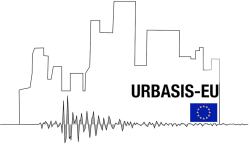WP4 - Vulnerability and risk assessment : improving the interface between engineering seismology, earthquake engineering and users
Modelling responses of a city to seismic ground motion is a critical component of engineering seismology and seismic hazard and risk assessments. The ground-motion prediction provided by WP1 and WP2 for LPHC events and induced seismicity will be tested in order to evaluate the potential danger from the ground motion with respect to the building response and the damage.
Development of testing procedures for comparing ground-motion prediction models (e.g., IPEs, GMPEs) will be proposed providing decision support for model selection.
The effects of spare data and incompleteness of information in urban areas for vulnerability and hazard assessment will be tested, focussing on related uncertainties and accuracy. The link between the ground motion and the damage prediction using modelling and experimental data provided by international databases will be explored to reduce the uncertainties in the damage prediction.
Building-specific analysis will be performed, also with exposure of the build environment assessed with innovative techniques that rely on crowd-sourced geographic data (e.g., from OpenStreetMap). In continuation, the time variation of the urban seismic risk during a seismic cycle (i.e., induced seismicity and co- and post-seismic periods) will be explored, including degradation of building properties due to repetitive shocks, and the rate of seismicity (natural or induced) developed in WP1 and WP2. Special attention will be paid to aftershock sequences and induced seismicity that generates ground motion that is variable in time and space. Economic aspects will be introduced for decision making, considering the cost/ benefit tools as a function of the policy of risk management.
Following the results of the previous WPs and the output of the recently completed (i.e., SYNER-G, NERA, REAKT, STREST) and ongoing (i.e., SERA, EPOS) European research projects in which URBASIS participants are/were involved, advanced methods and software tools will be developed to evaluate the global seismic risk in urban areas. In particular, a systemic approach will be followed, considering local hazard estimates, exposure of populations and services and vulnerabilities of individual components (e.g., buildings, utilities), as well as dependencies and interdependencies between and within systems in the urban fabric (i.e., building aggregates, water, waste water, gas, electricity, transportation). Relevant uncertainties in hazard and risk assessments will also be introduced into the systemic analyses. Physical losses will be assessed by adopting existing models for utilities and transportation systems. The software tools will be built on the platform developed in SYNER-G, considering functional consequences of damage and cascading failures.
Updated on 30 septembre 2020






